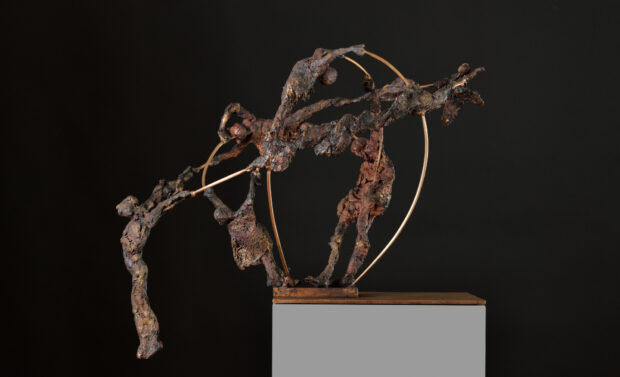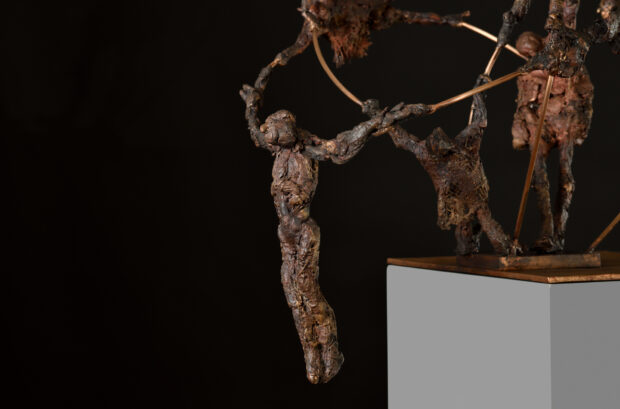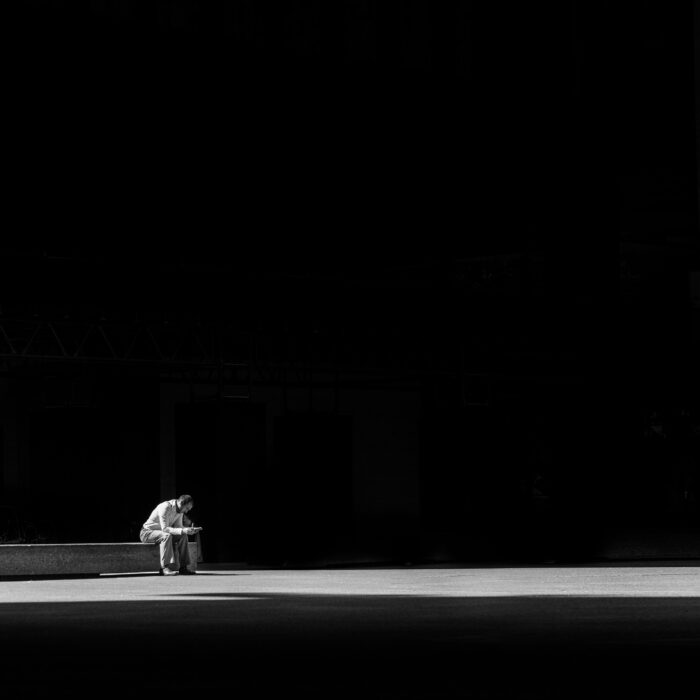You have no items in your cart. Want to get some nice things?
Go shopping
Sculptor Dr Gindi, explores the human soul’s yearning for infinity through her artwork. The enigmatic bronze figures she crafts defiantly reject the near-universal condition of uprootedness. Similar to philosopher Simone Weil, she explores the spiritual nature of life. Both Weil and Dr. Gindi urge the observer to consider L’Enracinement (“Rootedness”). Rootedness – or connection to self – is a source of energy, which helps us live satisfying, joyful lives. Her latest sculpture Meandering Souls captures one moment in the soul’s journey: the tender moment between longing and finding.
In my sculpture, Meandering Souls, I explore the process of disconnection and reconnection to ourselves, each other, and the infinite. This piece captures the will to undo the self. Simone Weil was unique among intellectuals of the 20th century as she articulated her philosophy as a series of distinctions through which the soul is drawn upward. For Weil, the human soul has a suite of antithetical needs. The fulfilled soul must be rooted, but able to take risks. The soul lives in a world driven by truth and equality while also allowing for freedom of expression. Being human demands our willingness to dance with and between these conflicting needs. Meandering Souls captures one such moment in the soul’s journey: the tender moment between longing and finding. When we are lost, we search outside of ourselves, grasping into the darkness for any anchor to hold onto. It is in the dire moments of grasping when we can, at last, let go. By facing the terror of uncertainty alongside our fellow travelers, we gain freedom by turning to the truth and infinity within.
Nothing is more difficult than finding ourselves unmoored. When we become disconnected, we are in the dark. At the individual level, disengagement with our relationships or vocations leads us to feelings of alienation. At the collective level, climate change, pandemics, and economic turbulence threaten our sense of safety, stability, and place. “To be rooted,” Simone Weil writes in her book L’Enracinement, “is perhaps the most important and least recognized need of the human soul. It is one of the hardest to define.” Being rooted is the essence of being human: from our birth, we are connected to our parents and our environment. It is only natural that when we lose our roots, we grasp for something to hold onto. The problem of searching, Weil notes, is that we are motivated by the anxiety of the void rather than the truth that is yet discovered. How can we begin to turn toward infinity when the void puts into peril our sense of self?
The process of searching and surrendering is exemplified in Meandering Souls. These souls whisper amongst each other, suspended in their own yearning. These souls require security, but echoing Weil’s idea of the soul, they also need to take risks. Weary of hardship and affliction, they are on the precipice of letting go: surrendering their egos and attachments in order to strive towards infinity and that which is beyond themselves. Despite the anxiety of freedom, responsibility, and belonging, they risk touching the untouchable within themselves. By confronting and overcoming the blockages in the unconscious they rest attentively in their encompassing desire for the infinite.

To attend to the void is to attend to the threat of our own fragility and mortality. For Weil, to de-create is our soul’s sacred task. When we are lost, we should withdraw our ego and our world-bound attachments in order to overcome the fear of death and turn toward the unknown. This demands of us disciplined attention that is both passive and active. While it may seem that our dedicated attention goes nowhere, Weil writes that “one day a light that is in exact proportion to [our efforts] will flood the soul.” Paying attention, for Weil, is a form of prayer. The task of the yearning soul is to turn towards without doing, and to open to all that is in our awareness without shying away. We detach from the outcome of our searching; rather than meeting our inner and outer worlds with rigid expectations, we meet both our painful and joyful experiences with mindfulness, loving-kindness, and acceptance.
Attending to the void, however, is often portrayed in solitude, in one’s own dark night of the soul. Not so in Meandering Souls. Even while lost, searching alongside others could give us the roots necessary to let go: to withdraw the ego and strive to encounter infinity. Why do we need each other to transcend our grasping impulses? Because between our searching and de-creating, we are confronted with the attraction and repulsion of the potential implicated in our human freedom and responsibility. If we are not careful, existential anxiety can preclude the possibility of forward movement. The souls are mirrors of each other. As such, bearing witness to the pains and tribulations of the other evokes a deeper intersubjective awareness. Our love for our fellow ephemerals gives us roots that nourish our individual and collective striving toward the infinite.

By coming together, we gain divine albeit earthly assistance in overcoming our neurotic inhibitions. When we are overly concerned with our egos, we become estranged from ourselves, from others, and from the divine. If we don’t turn our faces towards our true longing for the infinite, we risk getting lost in our superficial desires. Encountering infinity is possible only if we are willing to sacrifice our attachments in favor of something more universal and more expansive than our own ego. By doing so, we come to realize our true hunger is not in worldly possessions or lust, but in the sublime of the infinite.At last, in Meandering Souls, the souls begin to relinquish their egoic desire by turning first to face each other. Love for the other allows the self to transcend their self-created prisons, thereby beginning to realize their consummate burning for the infinite. The souls, together, traverse a uniquely human passageway. Beginning in painful, confused searching, we eventually garner the detachment, love, and attention necessary to face uncertainty within and without. When we finally face our true yearning, we are indelibly transformed by our pursuit of infinity.
About Dr Gindi
Always elusive and tantalizingly beyond grasp, the quest for infinity has captured humanity’s imagination for millennia. Aspiring to model the infinity of our existence, the works of sculptor Dr Gindi depict the current and perennial challenges of the human condition. Her classical training as a sculptor enables Dr Gindi to approach humanness more profoundly. Her sculptures are made from different materials. The most recent ones are generated from clay and later transformed into bronze. Embracing her transdisciplinary career path and multicultural upbringing, she has keenly observed humanity’s attempts to subjugate nature to cheat human decay. The characters in Dr Gindi’s works, who yearn for such an irrepressible urge for infinity, depict humanity’s dissociation from self and nature and attempt to redress this rupture by acknowledging their fleeting impermanence. “Submitting to fate and having a sense of resignation can often be the norm, but if we can transcend these attitudes, we shall be able to model the infinity of our existence”, she says.



